1001 Circles: Stephen Taylor’s Zometool Adventures
Have you ever dived into a river, lake, ocean, or pool? Have you ever done it in the dark or with your eyes closed? Much scarier, isn’t it? The prospect of leading a math circle, even a small one – your children and a couple of their friends, can be just as scary. While many people understand what a math circle is, few know what happens during circle time. “There be dragons!”
So we are starting a series of stories that show what a math circle might be like from the point of view of Math Circle leaders. We hope these stories will illuminate, inform and inspire you to lead a Circle of your own. And if you are a Math Circle leader, we would like to hear your story or interview you. Write moby@moebiusnoodles.com!
Meet the leader
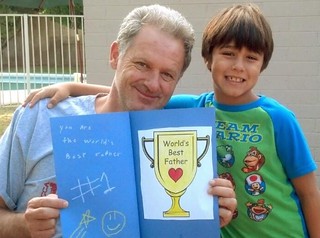
Stephen Taylor is an enthusiastic dad who happens to be an engineer and loves math. His son Kai also loves math and wants to be an engineer or soccer professional. His daughter is a math and reading wizard, and wants to be a doctor like her mom. Stephen has been teaching his kids math since before they could walk, and holding free and open workshops at their school. He loves watching children’s totally fresh approaches to problem solving. This is Stephen’s story about a series of parent and child Zometool workshops, held at a small school for three hours at a time, and centered on open, gently guided building tasks for small teams. The tasks nurture children’s creativity while introducing ideas of multiple dimensions, shapes and symmetry in nature and around town, and mathematics of beauty. A quote:
At their age, talking about many dimensions is no more abstract than talking about long division.
Would you run a workshop like Stephen’s? Read the story and decide!
Zometool Workshops to Stretch the Imagination, Fire up Creativity and Play with a Few Mathematical Concepts
I have always tried to make my brain work better. I know my mother worked really hard at that too. I was the last, by a long way, of five children. By the time I came along my mother knew how to raise a child – she was also a stay-at-home mom, and raising just one kid rather than four at a time was a cinch. She did not send me off to pre-school or kindergarten, but rather she kept me at home as her pal, student, game partner, and gardening hand – I swear we weeded the lawns for a whole year, or so it seemed. The result was that when I got to school, I was far ahead of my peers. Yes, individualized mother’s attention is probably the greatest gift we can give a child. But in today’s crazy busy world that does not seem to happen much. My kids came along, and luckily my wife and I had similar ideas about raising kids. We spent every free moment playing with our kids – board games, construction games, rail tracks, cards, Roulette, Black Jack, Chess, Blokus 3D, Pentago…. and Zometool.
Zometool is an advanced model building tool created to help mathematicians and artists discover form and shape, but is marketed and produced as a toy. It draws you into building domes, bridges, towers, pyramids, stars, fractals, crystals, hypercubes, sunflowers, and almost anything imaginable. It was invented by a crowd of hippie types in Boulder. I had stumbled across Zometool when I studied applied math at the University of Colorado. It is a mathematical tool or toy, depending on how you think. I fell in love with it as the toy (that’s how I think) and squirreled away a set for the day when I would have my own kids. That was rather optimistic thinking for a math nerd without a girlfriend in sight.
But it all worked out! So when my son got to kindergarten in a tiny school battling to attract students and money, I decided to hold Zometool workshops. I made the workshops free, as I just cannot charge to teach children mathematics. I produced a wacky flyer, and the editor at the local rag published a nice article for me.
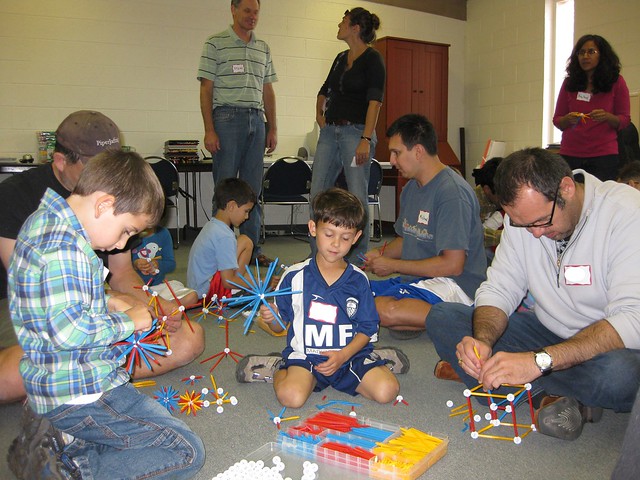
Photo: The workshop for 5 to 8 year olds (plus parents)
Before long I had mothers emailing me. They had to figure me out: Who is this guy? Why are these workshops free? And what is Zometool? Nearly everyone had the same line of questions, so I prepared a little slideshow for them, describing the workshop.

Picture: the 4D cube animation from the original slideshow
That seemed to do the trick in vetting me. Soon I had over thirty kids signed up, from all walks of life, including a large foster home and five area schools. Now I had to hold four workshops instead of just one. Good for the school, for the kids, for the parents, for mathematics, and at the end of the day, for me.
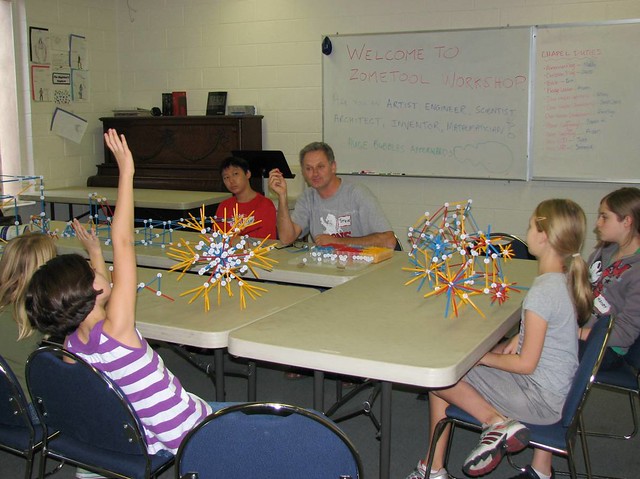
Photo: Studio discussions for 9 to 13 year olds
I chose a workshop format of “discovery learning” in which just enough guidance is provided to the kids to stimulate their own thinking and creating. I wanted the setting to be very “real world”, like an architect’s studio or a scientist’s lab. I also wanted the parents to attend and participate, with the rather mean objective of setting them difficult problems just so that their kids could see them struggle. This is because I believe such struggles show to kids that things mathematical do not just happen magically. People have to wrestle down math problems, to struggle and to pull out their hair. Also, and this is a big plus, the Zometool people promote workshops and send you these gigantic Zometool sets for just the cost of shipping. They also have a paper on how to hold a Zometool workshop.
My theme for the workshops was to stress the links between mathematics and beauty, as well as science and creativity. I also wanted the kids to really discover and learn, to think like they are not taught to think at school, to work as a team, to feed off each other’s ideas. I must say I was somewhat afraid that I could not pull off the whole thing!

Photo: The triangle challenge – build as many triangles as possible.
I formulated a little plan. I would have the Zometool pieces just lying around on the classroom floor. As the kids and parents came in, I would greet them and say: “The workshop is starting in 20 minutes. Please feel free to play with the Zometool.” No introduction, no “don’t break the parts” routine, no guidance: just discover the tool, in your own way. Luckily none of the kids or parent knew the toy, so it was fresh for everyone. After about 10 minutes, when I saw how engaged everyone was, my nervousness went away. Yes, I could keep them engaged for three hours.
After about thirty minutes I pulled them into the conference area and established the workshop setting. I explained the rules (or lack thereof) for working as a team of collaborators. Everyone was a teacher and everyone was a learner, and, my, did this work! The kids loved it. They contributed, they shared ideas. We had challenges, we discussed the challenges. We also discussed beauty and creativity. We talked about engineers, and artists and scientists, inventors and mathematicians. We spoke about 1-dimension, 2-dimensions, 3-dimensions, and many dimensions. At their age, talking about many dimensions is no more abstract than talking about long division, so this was no real sweat. Dads had to explain how they approached their challenges and their difficulties. And suddenly, there were no parts left. The gigantic sets, with over 4,000 parts had all been used by the kids and parents. This happened in every workshop.
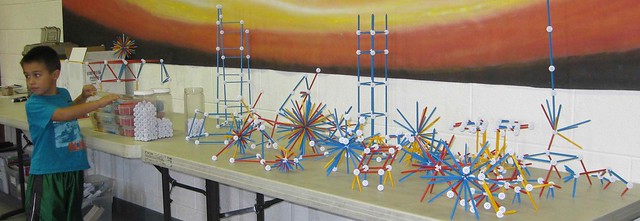
Next, we used the Zometool parts to create frames for making very large soap bubbles. We also played with the cool concepts of minimal surfaces and shapes of rotation. These active outdoor explorations helped to get the wiggles out of the kids before going home.
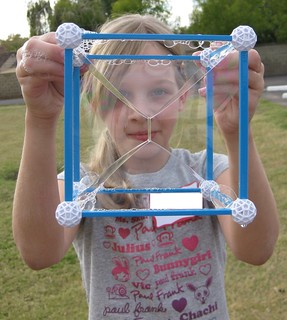
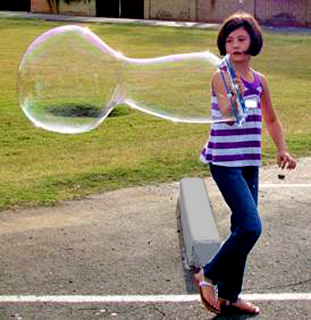
All in all, I was totally amazed! The kids were outstanding – maybe America’s children do not have a learning problem!
One of the little stars was an eleven year old, who produced one of the most beautiful creations, and was a key member of her team. A week or so after the workshop she was kind enough to write down the answers to some goofy adult questions for In the Zona magazine interview. She described her workshop experience, and the challenge for teams to build a dodecahedron, which was run as a race between teams.
Have you ever attended a workshop before? How is a workshop different from classroom learning?
No, I have never attended a workshop before. A workshop lets you create and discover if different things can happen, instead of just people telling you things and you believing them.
What did you create out of Zometool?
I created a kind of star thing.
Describe some of the other workshop participants’ creations. Did you notice a difference between the boys’ and girls’ creations?
A boy did a box inside a box and a girl did a kind of sculpture. The boys made things that you could tell what they are. The girls did more of just art.
One of the challenges was to create a dodecahedron as a team. Firstly, what is a dodecahedron? Did your team work well together?
A dodecahedron is a twelve-faced shape. We kind of did our own thing until the end, then tried to put it together, but some parts did not work, so we had to take them out.
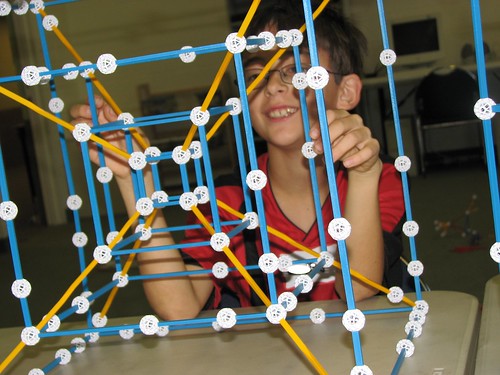
Photo: Cube in a cube in a cube.

Photo: Beautiful mathematical art – “a star thing”.
I felt proud of these little chaotic workshops, and how the kids were so willing to stretch their tiny – no, huge and flexible – minds. This would be a fine story to tell my Mom while weeding the lawn.
Posted in A Math Circle Journey, Make
#littlehousebigmath, and approaching maths backwards: Newsletter June 16, 2014
Subscribe to Moebius Noodles newsletters
Pinterest | Twitter | Facebook | Google+
I am Moby Snoodles, and this is my newsletter. Send me your questions, comments, and stories of math adventures at moby@moebiusnoodles.com

I am still wearing my math goggles from all the scavenger hunts we led at the Raleigh Maker Faire. If you missed it, join us online and at home for the #littlehousebigmath hunt! If you joined us at the Faire, welcome, and good talking to you again! Let’s have some adventures together.

“Bored in a math class” answers surprise the author
One of the questions asked at the Maker Faire was “my child is bored in math class. What can we do about it?” Rachel, a teen helping her mom Rodi Steinig with a book about math circles, asked the same question in several forums around the web: what to do if you are bored in a math class? She says many answers surprised her, but they make a lot of sense:
- Make the best of it by actually trying to change the contents or format of learning
- Ask the teacher for challenges (it’s not a request teachers get a lot in math classes)
- Invent little games and ways of playing, especially about the math in the lesson (Vi Hart’s videos have great examples)
Rachel will share the edited version of the collection in a few weeks – you won’t even have to wait for the book. Add your thoughts to the growing collection on our forum.
Speaking of books
Here is the news from several book projects, by and for the Natural Math network.
Camp Logic by Mark Saul and Sian Zelbo is for those who help children explore the underlying structures of mathematics. It is now in the last stage of reader review, after its crowdfunding campaign collected more than six thousand dollars to cover editing, layout, and printing. Thank you for making the campaign a success! You can pre-order paperback and electronic formats with some bonuses until the book launch in the Fall.
Playing With Math, edited by Sue VanHattum, is about to start its crowdfunding campaign on June 20th. This is a crowdsourced book of stories from math circles, family mathematics, and playful classes – about fifty people contributed chapters, art, and puzzles. It has 300+ pages, the largest of Delta Stream Media book projects to date.

These books will be published under the open Creative Commons license, so everybody can check them out, remix the activities, translate, and otherwise spread the love of mathematics.
The London Mathematical Society published a review of Moebius Noodles, by one of my heroes, Alexander Zvonkin, a pioneer of early advanced mathematics. This is my favorite quote from the review, where Alexander totally gets the main hopes and dreams of our project:
“Sometimes, the authors’ enthusiasm makes them exceedingly optimistic. They say, “In general, the answer to ‘Can young children understand the concept of… ?’ is always ‘Yes!’”, and go on: “But seriously, can you teach any concept at any age?” Apparently, their answer is once again yes. This conviction, if we consider it as a purely scientific statement in the realm of developmental psychology, is certainly wrong. But such ideas should not be judged only as right or wrong. In the first place, this idea is productive. This means that it is not so much a statement as it is a challenge, an appeal to dare, to go ahead without fear and try to invent new activities, new games and circumstances which could eventually acquaint your child with the concept you have in mind.“
Since Moebius Noodles came out a year ago, the Natural Math crew has been working hard to address an aspect the review also mentions. We are now building many more bridges between art activities, free play, games, and other informal mathematics – and formulated, abstract, explicit mathematics. Without such bridges, people who are strong at formal math don’t consider informal activities “real mathematics” – and people who are weak at formal math miss the full richness of mathematical concepts implicit in the activities. These days our materials have stronger scaffolds that help everyone to find, grasp, and share all the deep math behind beautiful art and free play.

For example, this info card accompanied our weaving activity, a hit at the Maker Faire last week. The card gives math terms, whys behind the fun, and an answer to a frequently asked question: “What if my child just weaves randomly, without creating or exploring a pattern?”
Blogs and networks: approaching maths backwards
Sue Elvis at Stories of an Unschooling Family blog writes about her revelation: mathematics can be approached in “the usual” direction of curricular sequences, or backwards, sideways, and every which way. In comments, she says since she started talking about this with other parents, many people came out and said it made total sense:
“I have been surprised at how many people understood what I was trying to say in this post, despite me finding it hard to put it into words. It could be there are a lot of children who work better using a backwards approach.”
I see this trend as well. For example, a recent Y Combinator forum thread discussed graph theory topics Joel David Hamkins presented for his 7-year-old daughter’s class. I love the activities, and what Joel David named his daughter, and the kit for a little booklet on graph theory your kid can make:

Meanwhile, at the Gray Family Circus blog young kids are seen enjoying young calculus activities such as infinite series from our spring online course. Andrea Gray writes:
“I took a great class at Moebius Noodles and got a lot of ideas for hands-on math fun… Mary had the idea for the Colby Car substitution fractal.”

Is your kid like that? Is your child learning algebra before arithmetic, doing long addition left to right, skipping all over Khan academy exercises, or otherwise “approaching maths backwards”? Share your story!
Sharing
You are welcome to share the contents of this newsletter online or in print.
Talk to you soon! Moby Snoodles, aka Maria Droujkova
Posted in Newsletter
What Math Do You Have in Your House?
 Last Saturday was crazy! The mini-Maker Faire NC was a large, noisy, bright and exciting event. 6000 people of all ages spent 8 hours 3D printing, sewing wearable electronics bowties, creating music with a few carrots and a MakeyMakey kit, taking apart old printers, practicing sword fighting, and learning to tattle.
Last Saturday was crazy! The mini-Maker Faire NC was a large, noisy, bright and exciting event. 6000 people of all ages spent 8 hours 3D printing, sewing wearable electronics bowties, creating music with a few carrots and a MakeyMakey kit, taking apart old printers, practicing sword fighting, and learning to tattle.  And amidst all this excitement, right next to a giant marble run and across from a table with life-size puppets, was where we set up our little math house. It was a last-minute idea and a hasty run to the nearest home improvement store. We got some PVC pipes and fittings, plastic safety fence, and lots of ducttape and zip ties.
And amidst all this excitement, right next to a giant marble run and across from a table with life-size puppets, was where we set up our little math house. It was a last-minute idea and a hasty run to the nearest home improvement store. We got some PVC pipes and fittings, plastic safety fence, and lots of ducttape and zip ties. Our little math house, when put together (which took about 15 minutes once PVC was cut to size), was just a bit sturdier than the stick house of the second little pig. It wouldn’t stand up to even the weakest of the Big Bad Wolves. It was time to strengthen it with lots and lots of math. We filled our little house with tools for building big mathematical ideas: weaving grids (check out our posts about weaving and math here, here and here), puzzles, geometric origami decorations, and photographs of beautiful math hidden in plain sight all around town (from Math Trek scavenger hunts).
Our little math house, when put together (which took about 15 minutes once PVC was cut to size), was just a bit sturdier than the stick house of the second little pig. It wouldn’t stand up to even the weakest of the Big Bad Wolves. It was time to strengthen it with lots and lots of math. We filled our little house with tools for building big mathematical ideas: weaving grids (check out our posts about weaving and math here, here and here), puzzles, geometric origami decorations, and photographs of beautiful math hidden in plain sight all around town (from Math Trek scavenger hunts).  Still we were a bit worried. Would our little house even be noticed in all the excitement of the Faire? With over a hundred Maker displays, most of them hands-on, would the children want to come in and play for a few minutes? Most importantly, would our little house lead the adults to thinking about mathematics in their homes?
Still we were a bit worried. Would our little house even be noticed in all the excitement of the Faire? With over a hundred Maker displays, most of them hands-on, would the children want to come in and play for a few minutes? Most importantly, would our little house lead the adults to thinking about mathematics in their homes?  Well, the house did get noticed and was played in. Kids spent a while there weaving, exploring puzzles, and playing with the balance scale. Adults looked at the photographs and talked to us about mathematics in their lives and in their homes. And now we’d like to continue this conversation.
Well, the house did get noticed and was played in. Kids spent a while there weaving, exploring puzzles, and playing with the balance scale. Adults looked at the photographs and talked to us about mathematics in their lives and in their homes. And now we’d like to continue this conversation.
So look around your house. What math do you see? What math that you see can your kids see, touch, make, and enjoy?
Share your finds in the comments, on our Facebook page, on Twitter @NaturalMath with #littlehousebigmath, or e-mail your finds to moby@moebiusnoodles.com
Posted in Grow
Math You Make; Camp Logic blog carnival; Knight’s Tour game – Newsletter May 30, 2014
Subscribe to Moebius Noodles newsletters
Pinterest | Twitter | Facebook | Google+
I am Moby Snoodles, and this is my newsletter. Send me your questions, comments, and stories of math adventures at moby@moebiusnoodles.com

Math You Make, Math You See

Do you think of math as something that “you have to solve”? Or perhaps as something that “you can play with”? How about math as something that “you want to see” or even something that “you can make”?
As we are getting ready for our first ever Maker Faire, we are thinking more and more about the DIY aspect of mathematics. Of course, there is no shortage of project ideas for DIY manipulatives that adults make and present to kids. What we’re doing with manipulatives is different:
- Usability outside of math lesson – we often hear that math, as it is frequently presented to kids, is disconnected from the real life. One way to restore the connection is to create manipulatives that can be used in many contexts, for example, art pieces, objects to include in children’s play, things that enrich storytelling.

Covariance Monsters by Bloke School - Child-friendly process – if you can’t make a manipulative together with the child, as part of the math exploration, then don’t make it at all.

Follow these two conditions, and the mathematical conversations that spark naturally, as you are making a manipulative, will lead to deep mathematical explorations. Which in turn leads to noticing more math in more places!
Camp Logic – First Chapter Unlocked, Blog Carnival Coming Up
There are just a few more days left until the end of the crowdfunding campaign for Camp Logic, the book that explores, in a playful way, logic and mathematical reasoning. Thank you, contributors!
Reaching our first crowdfunding milestone of $3000 meant that we could make the first chapter of the book available for you to review and comment on. If you haven’t checked it out yet, here’s the link to the chapter.
And now we’ve reached the second milestone with over $5000 raised. This means that in June we will hold a blog carnival at MoebiusNoodles.com It will be bursting with mathematical goodness – games, activities and mathematical art you can make with your children.
So what’s next? Reaching the $8000 milestone means we will hold a special Math Cafe with the book authors. You will be able to attend virtually or, if you are in New York City, in-person. Plus, for all pledges of $8 or more, you will also get electronic versions of the book. Pledges of $20 or more will get you a paper copy of the Camp Logic book. So don’t wait, contribute now.
Bored in a Math Class?
Okay, so this happens to all of us. We get bored. Bored in math or history or biology classes. Bored in meetings or on conference calls. How to deal with such boredom is the question we are exploring on the Ask forum. View boredom (whether your own, your child’s, or your student’s) not as a sign of personal failure, but as a call from your brain that it needs to do something creative, for example:
- Make up a game or a riddle out of what bores you
- Doodle
- Play an existing game, like Knight’s Tour (below)
Find more ideas and add yours to the growing collection on the forum!
The Knight’s Tour – A Grid-Hopping Game
https://www.youtube.com/watch?v=ab_dY3dZFHM
When I sat bored in a class (and not only in math class), one of my favorite games to play was the Knight’s Tour game. The way it was taught to me was on a 10×10 grid. But you can play on smaller (or larger) grids, like 5×5 or the traditional chessboard’s 8×8. By the way, you can play it on any rectangular grid, so don’t limit yourself to a square. So here we go:
- Draw a grid
- Pick your starting cell and write “1” in it
- Move as a knight would move in chess and write “2” in the cell you land in.
- Move again and this time write “3” in the cell you land on.
- Continue until either you visit every single cell once and only once or until you cannot make another move.
This game will present many choices (apart from the size of the grid itself) – where to start, which way to move first, which way to move next, should you backtrack to the skipped cells? Play a few rounds, and some patterns start to emerge. The game itself is simple enough to be taught to young kids: you can reduce the grid dimensions, increase cell size, and use stickers instead of numbers to mark already-visited cells. But the math behind the game is not simple at all. Enjoy!
Sharing
You are welcome to share the contents of this newsletter online or in print.
Talk to you soon! Moby Snoodles, aka Yelena McManaman
Posted in Newsletter




